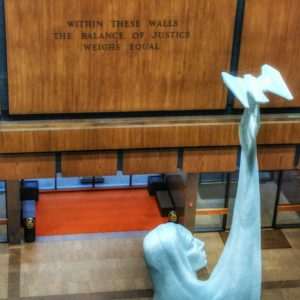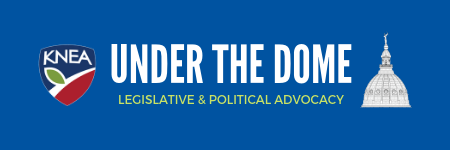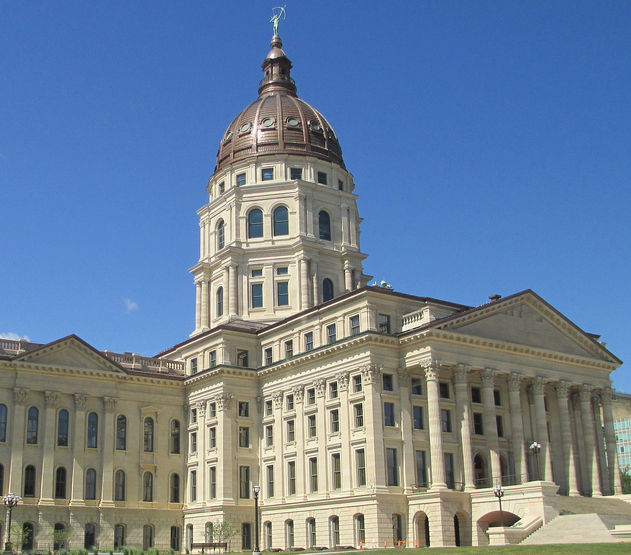If SB 19 is unconstitutional, what about the new funding our schools are getting?

“Within These Walls the Balance of Justice Weighs Equal.”
You may be wondering what immediate impact Monday’s Kansas Supreme Court ruling will have on your school and district. We’ll try to clear things up as much as possible.
First, you may wonder about how this impacts the new money received under SB 19 now that SB 19 has been found to not meet constitutional requirements. There should be no significant impact on funding. The Court has not stopped the state from providing the funding specified in SB 19 and schools should continue to be funded just as they have been from the start of this school year.
There will also be no impact for this school year based on the four equity issues raised as unconstitutional by the Court. For example, if your district has already shifted some insurance payments to the capital outlay fund thereby freeing up a few dollars for other purposes, that may continue until June 30, 2018. The 10% floor for at-risk funding which has been ruled unconstitutional will also continue for this school year but not into the next. This would only impact two districts in the state so will have no effect on most of you.
If your local association and board of education are still seeking a contract settlement, the funding in SB 19 should not be holding up such a settlement – your district has the funding promised in SB 19 for this school year. But since the Court has ruled the overall level of funding to be inadequate, it is safe to assume that there will be more money in the next school year than was provided in SB 19.
Was this a unanimous decision? Was there no dissent?
This was indeed a unanimous decision on both issues of adequacy and equity, however, there were dissenting opinions on the timelines within the decision.
The Court majority has determined that the Legislature will have the 2018 regular legislative session in which to resolve the issues raised in the decision. As we reported Monday, they will not allow the Legislature to drag its feet and set specific early dates for briefs to be filed and oral arguments to be presented. The Legislature will not be able to string out the process until the very end of the session.
Justices Johnson and Rosen, while agreeing with the rulings on both adequacy and equity, dissented on the timeline preferring that the Court would require a remedy by the end of 2017. Justice Biles also agreed with the rulings on both adequacy and equity but dissented on allowing the unconstitutional equity provisions to continue until the end of the school year preferring that those issues be blocked from implementation immediately.
So, what happens next?
For right now, schools can operate “business as usual.” Nothing is being stopped or taken away; the Court specifically stayed their order until June 30, 2018.
The Court has directed the Legislators and Plaintiffs in the case to submit concurrent briefs by April 30 and response briefs by May 10. This means that the legislative remedy needs to be created, passed, and signed into law in time to meet the April 30 deadline. Oral arguments in the case are scheduled for May 22, 2018, and the Court will issue a ruling on or before June 30, 2018.
The Court justified their hard deadlines by saying,
With that regrettable history in mind, [that the K-12 system has been underfunded for many years] while we stay the issuance of today’s mandate through June 30, 2018, after that date we will not allow ourselves to be placed in the position of being complicit actors in the continuing deprivation of a constitutionally adequate and equitable education owed to hundreds of thousands of Kansas school children. Cf. Campbell County School Dist., 32 P.3d at 332-33 (cited in Gannon II, 303 Kan. at 739). See Gannon IV, 305 Kan. at 919.
They are saying, in essence, that a delay that makes rendering a new decision prior to June 30 impossible, will not be tolerated. They expect to be given time to consider the new remedy, hear arguments, and deliberate and not be put in a position like this year when the bill was finished so late, they had little choice but to let it go into effect pending the Court hearing.
We would expect that between now and the start of the 2018 legislative session, legislators on all sides of the issue will take an opportunity to attack someone for the position they’ve put themselves in. Some will berate the Court for imposing its will on the Legislature; others will go after Brownback and his legislative allies for crippling the state’s revenue stream so there was no money for schools, and some will say that this is exactly what they expected.
We hope the posturing will be finished soon (you’re probably reading all about it in your local paper now) and that cooler heads will start thinking about solutions. SB 19, in the form first drafted by Rep. Melissa Rooker (R-Fairway) and Senator Laura Kelly (D-Topeka), represented a bipartisan effort and was an excellent start that was eventually whittled down and then loaded up with inequitable policy provisions. We know there are legislators on both sides of the aisle willing to meet their constitutional obligation.
It’s going to take work and courage. We’ve stated previously that any solution would require the Legislature to address the state’s revenue crisis and that solving the school funding problem requires sensible tax policy. While we’ve made significant strides in the right direction, we need to understand that fixing the mess left by Governor Brownback and his allies will be a marathon and not a sprint. Yet, the framework for a solution is there and a solution can be crafted. It will take additional revenue and it will take a desire to stay away from inequitable policies. We look forward to working with legislators to get the job done. Kansas simply cannot afford to delay any longer.



